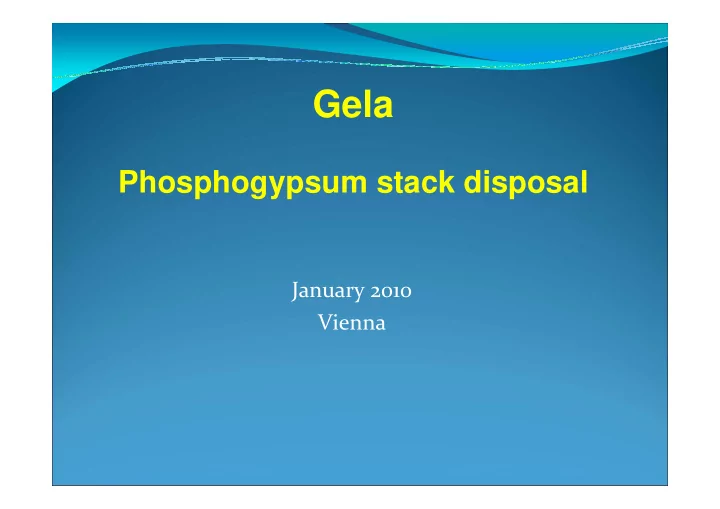

Gela Phosphogypsum stack disposal January 2010 Vienna
The disposal is placed within the boundary of a large industrial area; it was remediated under the control of environmental Ministry in compliance with the regulation for chemical pollutants. Hydraulic control (extraction-monitoring-treatment) of internal and external underground water is mandatory for any kind of industrial waste disposal, in order to limitate the migration of hazardous pollutants; it can be stopped when the remediation actions determinate a permanent reduction of the contaminants concentrations, below the limits. Capping (plastic) and covering with clean soil are also required. Authorisation for discharging other kind of new waste material is generally neglected. Final destination of the area: solar power plant installation.
MAIN QUESTIONS 1)Is this kind of remediation safe also for the radiological protection? 2)Dismountling the old phosporic acid plant and disposing it into the confined landfill produce a variation in the source term. Is the remediation still safe, allowing for a new discharge authorisation?
Details of containment barriers are available Pumping wells B B e e Soil Soil n n Bentonitic wall t t o o n n i i t t i i c c phosphogypsum w w a a l l l l Ground water percolate Sand lens (?) Clay layer
Gela disposal
It could be useful: to asses the evolution in time of the migration of the relevant radionuclides in absence of any phisical barrier, in order to represent the situation before the action of remediation (current measurement in gound water show contamination probably due to the previous landfill configuration). to simulate a test with radioactive tracers for the integrity of wall/clay system (real test requested by the Ministry)
Summary of available data: � the stack is positioned in an area where a bed of clay (hydraulic conductivity ~ 10- 12 × 10-11 m s-1, thickness = 20-30 m, depth = 7-21 m) is present; the clay bed extends for hundreds of hectares; the hydraulic conductivity of phosphogypsum is 5 × 10-6 m s-1; � the clay bed and the surrounding concrete retaining wall, inserted in the clay bed for 2-3 meters, should form a barrier for the superficial (i.e. over the clay bed) groundwater normally flowing from NW to SE; no investigation exists on presence of groundwater below the clay bed; � the superficial groundwater is not permanent, i.e. it completely depends on rainfalls, which is very rare but intense; for long periods in a year piezometers and wells, outside the N-NW side of the stack are dry; therefore groundwater samples are not collected on a regular basis; � in the SE corner outside the stack wall, where the sampling points Pz 02/05 and Pz 11/05 are, a lens of sand receives water from the superficial groundwater getting around the stack and from the surrounding hills; for this area information needed to model the dispersion of NORM is available: � hydraulic conductivity: 2 × 10-4 m s-1 � Darcy velocity: 5 m a-1 � the depth of water is 6.25 m in Pz 11/05 which is at 12.30 m above sea level; the depth of water is 4 m in Pz 02/05, which is at 10.4 m above sea level
Recommend
More recommend